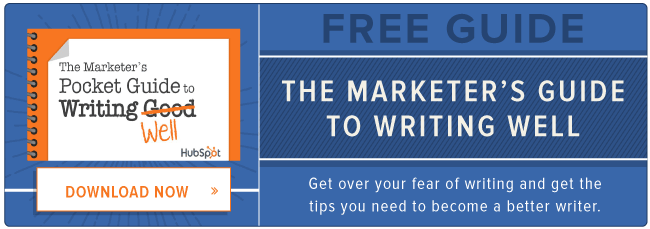
As we all know, content creation isn’t as simple as just stringing together a few words and hitting "publish.“ At least all high-quality content creators know this.
If you really think about it, the editorial process has quite a few steps – from ideation, to concepting, to production, to proofreading, editing and copyediting. Unfortunately, it’s that last part that often gets undermined, rushed through, or altogether just swept aside as writers and content creators hurry to get content out the door. But if you really want to ship remarkable, high-quality content, you can’t afford to overlook the proofreading and editing process.
The problem is, it can be difficult to remember every little editing consideration you should be making. So in an effort to make things a little easier on you, we compiled a complete online editing and proofreading checklist you can bookmark and use to make sure your next piece of content is ready and raring to go, whether it be a simple blog post or something longer form, like an ebook.
The Content Editor’s Online Proofreading, Editing, and Copyediting Checklist
Topic Selection
Consider these high-level questions at the beginning stages of the editorial process. (Tip: Ask contributors to show you a working title and/or a brief outline for the piece of content before they start writing so you can steer them in the right direction and save writers’ time.)
Does this topic align with our content strategy? Will our readers/
buyer personas care about it?
Have we covered this topic comprehensively in the past? Will it add anything new and interesting amongst all the content clutter on the web? If both answers are yes, consider
updating and republishing the original draft.
Can the angle be tweaked to be even
more interesting?
Article Structure & Formatting
Optimizing the way the writer organizes their content and ideas is an important part of the editing process. Ask yourself these questions to determine whether the content is structured and formatted in an optimal way.
Is this the right format for the content? Does this topic work better as a longer form ebook, or a blog post? If it’s a blog post, should it be formatted as a
list post, a
yin and yang-style post, or a
LEGO-style post, etc.?
Is the flow of the content logical? Are the chapters/headers/ideas organized in an order that makes sense and naturally guides readers through the content?
Are big chunks of text broken up with headers and paragraph breaks so it’s easier on the eyes and readers can scan and skim?
Are your headers formatted consistently – not just within this piece of content, but across other pieces of content? Are different header styles (H2 vs. H3 vs. H4) being used to properly denote content hierarchy?
Is the content comprehensive? Are all major points associated with the topic covered in the post?
How is the formatting? Can you incorporate numbered lists and/or bullets to make it easier for readers to skim, scan, and identify important takeaways?
Are important points/stats/ideas called out in bold to catch readers’ attention?
Are supporting images and visuals included where appropriate?
Are these visuals and images
high quality and interesting? Have they been resized and compressed so keep page load time reasonable?
Writing / Copyediting
This section is pretty important, for obvious reasons. Here are the critical things to consider as you’re evaluating the writing in and of itself.
Is the content well-written? It the writing interesting, entertaining, and easy ot read?
Does the content tell a story?
Do the transitions make sense and flow well?
Is the grammar correct?
Does the intro tee up the rest of the content well and explain the value the reader will get out of reading it?
Are the headers keyword-optimized (see also the section about search engine optimization) , compelling, and clear?
Does the tone of the writing align with the content being presented? Does it align with the
persona being targeted?
Does the content’s voice jibe with the overall voice of our content and company?
Yet, are we still allowing the writer’s individual writing personality to shine through?
Supporting Elements
Here are some additional tips that can transform your content from okay to awesome.
Did we include examples (real or hypothetical) to illustrate our points?
Did we use data, statistics, and quotations to back up our points? Is the content well researched?
Are there other supporting elements that could enhance the content (e.g. a SlideShare, a video, a visual, etc.)?
Attribution
Any good editor makes sure he/she is giving credit where credit is due. Here’s what to think about.
Are statistics, data, quotes, ideas, etc.
properly attributed to the original source with a link back?
Is the data interpreted correctly (i.e. not lost in translation) from the original source?
In any quotations, do we have the right spelling of the name and job title/company of the person quoted?
Are we actually
allowed to use these photos/images?
(Here’s a cautionary tale about internet copyright law.)
Title Selection
The title/headline of your piece of content is often the first impression it gives off (think social media shares, search results, etc.), so it’s important to put some time and careful thought into its selection. Here’s what to consider.
Is the title compelling and interesting enough to get people to click through and read on?
Does the title accurately reflect the content within? Avoid being overly sensational or bombastic.
Is the title brief and concise? (Tip: Keep in mind longer titles will get cut off in search engine results.)
Is the title keyword-conscious without being keyword-heavy and sacrificing user experience and clickthroughs ( see also the section about search engine optimization)?
Style Guide Alignment
Written style guides serve as the commonly acknowledged authority when questions of grammar, punctuation, and style come up in writing. A style guide answers questions like whether you use title case for article titles and headers; whether you capitalize the word internet; or whether you use the Oxford comma.
You can either adopt an already-established style guide, like the AP Stylebook, or create an in-house version that enables you to borrow from different schools of thought and address any nuances specific to your industry or company. The important thing is to be consistent across all content you publish. Here’s the main question you should ask yourself …
Does anything contradict our style guide?
(Tip: If you don’t have a style guide, you can download HubSpot’s and customize it as you see fit.)
Search Engine and Conversion Optimization
Want to get your content ranked for relevant keywords in Google and other search engines? Don’t forget on-page SEO best practices. Then make sure you’re converting all that traffic by doing some conversion optimization as well. Here’s what to consider.
Have you done your
keyword research to identify relevant keywords with which to optimize your content?
Did you optimize your content using
on-page SEO best practices, incorporating your targeted keywords into the page/post title, URL, headers, and body content (especially within the intro) where appropriate – without over-stuffing?
If it’s a blog post or web/landing page, is there a catchy, concise, and clear meta description to encourage clickthroughs in search engine results pages (SERPs)?
Finishing Touches
You’re almost done! But don’t overlook these finishing touches.
Are there internal links to other resources, landing pages, or blog articles that might be helpful to the reader (or improve your SEO)?
Were those links tested to confirm they work and send readers to the right place?
Is the content spell-checked?
Are any company names referenced spelled and styled correctly? (Tip: Pay particular attention to CamelCase, lowercase, one vs. two words, etc.)
Does the content contain any sensitive or controversial information that we need to get anyone’s approval on before publishing (e.g. our legal or PR department)?
Have any stats cited or quotes used (etc.) been fact checked?
If it’s a blog post, is it tagged with the appropriate topic tags?
Was the publish date/time double-checked so we’re not accidentally scheduling for 8 p.m. instead of 8 a.m.? (It happens. We’ve done it.)
Final Sanity Check
Now that all the nitty-gritty edits have been made, sit back and take a look at the content holistically. Then ask yourself these questions …
Could anything in this content be potentially harmful to any of our partners, stakeholders, audience, or our company itself?
Could this offend certain people in our audience? If so, is it worth it?
Did we double-check any mathematical calculations we made ourselves?
Is the content at odds with our company’s mission, philosophy, goals, etc. in any way?
Did we miss any opportunities to build a relationship with influencers, industry thought leaders, etc.?
Content Promotion
Once you hit publish, your work shouldn’t end there. Last but not least, make sure you’re getting the most bang from your buck with these promotion tips. (Get more content promotion tips in our free Comprehensive Guide to Content Promotion.)
Have you promoted it in relevant social media channels?
Have you emailed it to subscribers, leads, and other relevant contacts in your database?
Can you put some paid promotion behind it using paid platforms like Outbrain, Keywee, or via advertising options available by social media sites like Facebook and Twitter?
Can you syndicate it to other publishing platforms like LinkedIn Pulse or Medium to expose it to other audiences (just be sure you reference and link back to the original post on your site)?
What else would you add to this proofreading and editing checklist? Happy editing!



from HubSpot Marketing Blog
http://ift.tt/1cMDhg6
Mobile Marketing
from Tumblr http://ift.tt/1OO6sAB

No comments:
Post a Comment